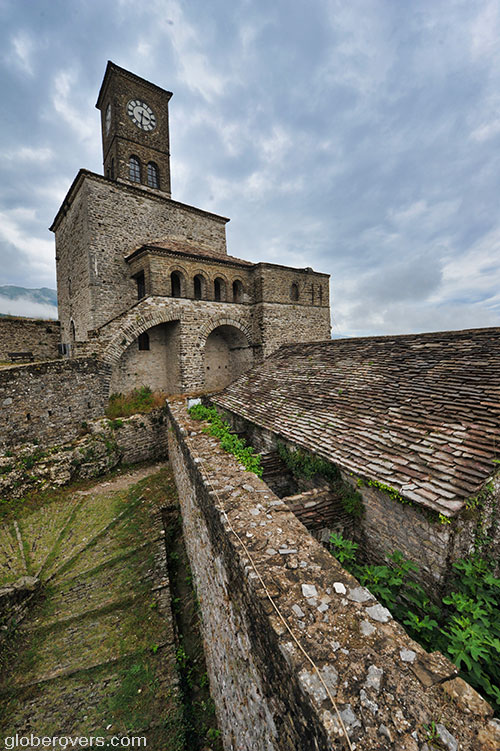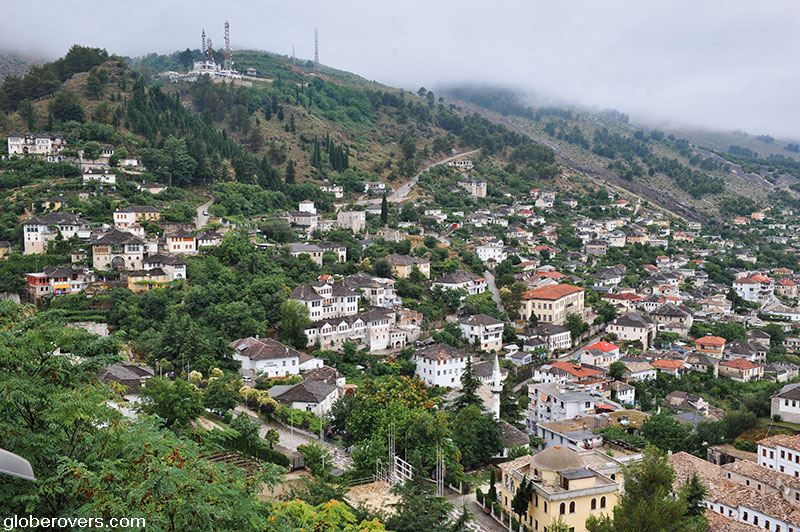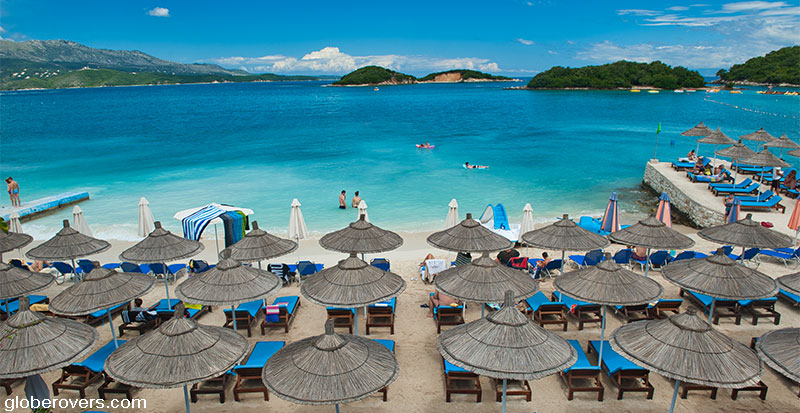
Albania has been Europe’s most intriguing enigma while it has been closed to outsiders for much of the 20th century. During this time, the country has been rumoured to have some of the most spectacular mountains, ancient ruins, historic fortress towns, turquoise Mediterranean coves, and long stretches of sandy beaches.
Why travel to southern Albania?
- The low-down: Albania has long been sitting on the back-burner to be discovered by travellers. For many years, foreigners were not allowed in, and even after the country opened up, little has been done to promote the beauty of the country. This is changing rapidly as more travellers realize just how incredible Albania is.
- The brightest highlight: While Albania has much to offer, the highlight for me has been the turquoise beaches along the southern coast – referred to as “Albania’s Riviera of the Ionian Sea”.
- Intrepid destination: Albania has been void of mass tourism for a long time but this is changing. Popular beach destinations can get crowded in the summer months, though many off-the-beaten-path destinations along the coast and in the mountains are patiently waiting to get on the travellers’ map.
- Globerovers score (10 is highest): Albania is a gem along the Adriatic and Ionian seas waiting to be discovered. I’ll score it 8/10.
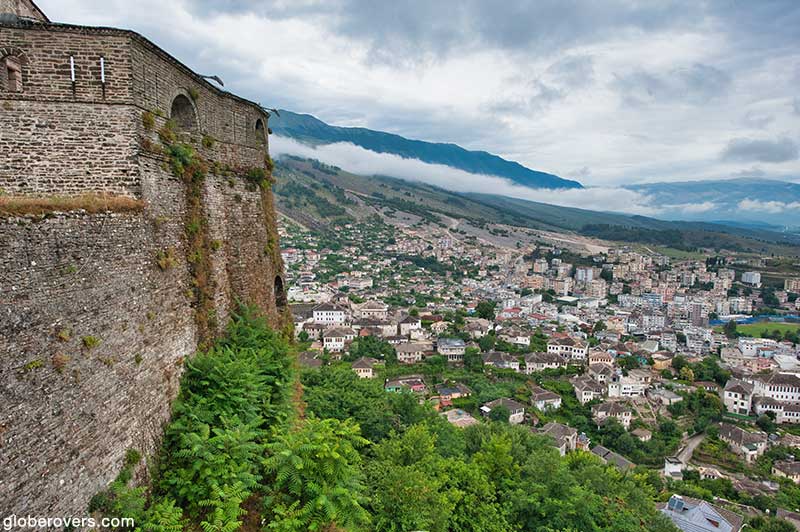
Table of Contents
Albania’s isolation under Enver Hoxha
Not long after Mussolini, the Italian dictator, invaded Albania in 1939, the monarchy was abolished and King Zog deposed. The Communist Party was formed with Enver Hoxha, another brutal dictator, as ruler. When the Italians surrendered to Hoxha’s Communists, the Germans stepped in and occupied Albania. Months before the fall of Hitler, the Germans withdrew and Hoxha created a totalitarian regime based in Tirana, the capital. The Communists began to nationalise all industries and years of international isolation followed.
Hoxha, a staunch atheist, did all he could to eradicate all traces of religion from Albania. He destroyed religious buildings and banned all religions. Even though Hoxha died in 1985, his tyrannical regime continued until national elections were held in 1991, at which time religious freedom was reintroduced and Albania slowly opened up to the outside world.
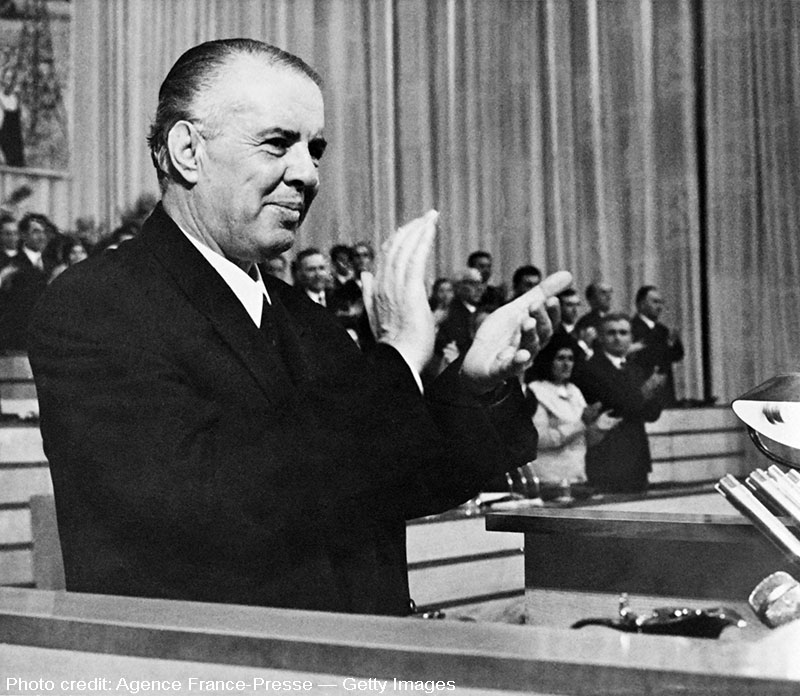
died on Feb. 26, 2020 at her home near the capital, Tirana. She was 99.
Albania remains free of the shackles of Communism but is one of Europe’s poorest countries with a small population of about 2.8 million. The scars of years of rule under the Communists have been slowly fading over the past 20 years. Today little is visible, except for some Stalinist statues and architecture, and the occasional sighting of one of the many bunkers built during the rule of Hoxha to protect against his imaginary invasion from foreign powers.
The country’s abundance of natural beauty, relatively low tourist numbers, affordable travel, ethnic cuisines, and friendly people are attracting an increasing number of curious international travellers. As word gets out about what Albania has been hiding behind its Communist iron curtain, it’s more than likely the current trickle of tourists will become a flood and threaten this hidden gem with the horrors of mass tourism.
The interior route to southern Albania
With Enver Hoxha on our minds, we head south on the interior route (rather than the coastal route) from the capital, Tirana, to start our Albania trip in Gjirokastër. Hoxha was born in this sleepy mountain village in 1908, so Gjirokastër has been of significant interest to the Albanians for many years. The current Gjirokastër Ethnographic Museum stands on the site of Hoxha’s birth home and offers an insight into the traditional lifestyle of the people of Gjirokastër.
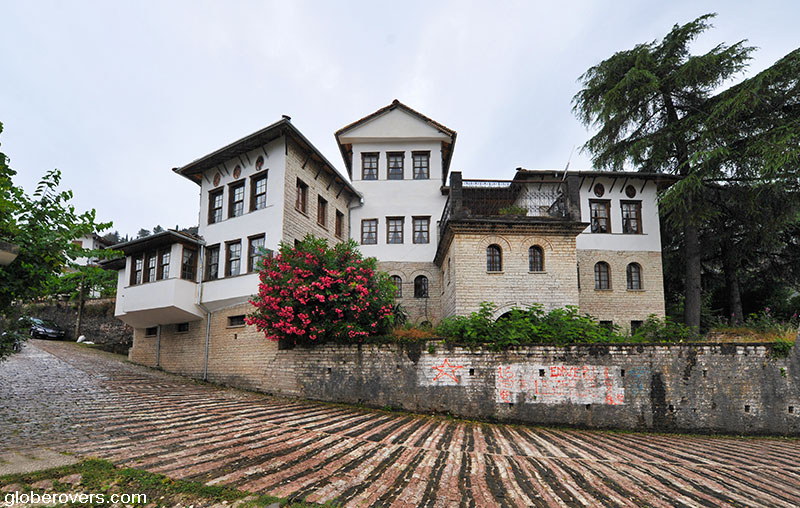
From Gjirokastër, we travel southwest to the port town of Sarandë (or Saranda) which lies along the so-called “Albanian Riviera”.
A short drive further south of Sarandë, at the bottom of an isthmus, squeezed between the cobalt-coloured Adriatic Sea and a lagoon famed for its mussels, lies the pretty beach town of Ksamil. The entire area surrounding the tiny town is a protected green zone. The coastal waters here are shaded in an idyllic turquoise hue and blessed with three small islands, the nearest within swimming distance from the town’s main beach.
We end our travels through southern Albania a few kilometres southeast of town, at the ancient ruins of Butrint. The ruins, inhabited since prehistoric times and once part of the Greek and Roman colonies, are situated in a lovely natural setting. Look out for the old Roman Theatre, Venetian Castle and the Great Basilica.
Albania is a gem waiting to be discovered and appreciated.
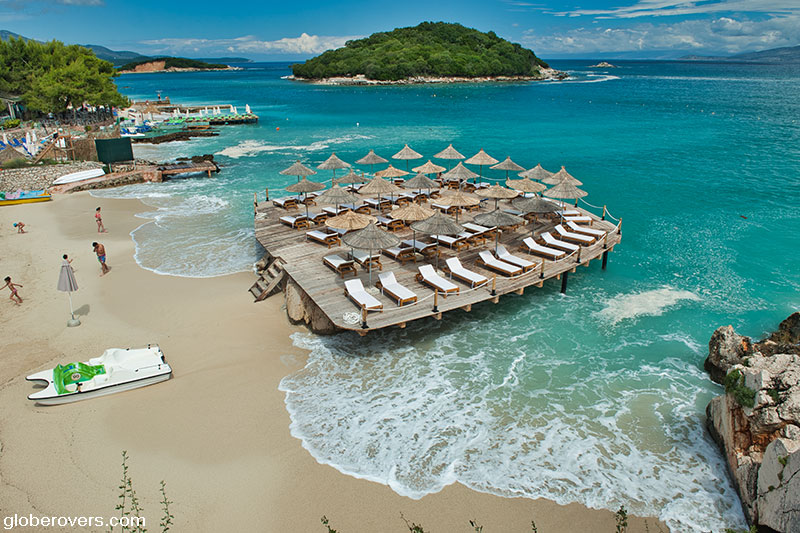
Gjirokastër mountain village
Defined by its imposing castle, Gjirokastër (also written as Gjirokastra) has been a settlement for well over 2500 years. Today, only the castle, its 600-odd Ottoman-era houses, and its narrow and steep roads paved with chunky limestone and shale can attest to its more recent history.
To the Albanians, the town is an unwelcome reminder of their former ruler, Enver Hoxha, who was born here. As dictator Hoxha ruled Albania with an iron fist for four decades, he ensured that the town was relatively well preserved during his rule. A much-hated figure, he is not memorialised anywhere in the town.
Dictator Hoxha who ruled Albania into the ground was born in Gjirokastër in 1908
Listed as a UNESCO World Heritage Site, the town is located in a valley between the Gjerë Mountains and the Drino River. Its enchanting old town is perched on a hill that overlooks the entire valley and surrounding mountains. The beautifully decorated old houses are tightly arranged up the hills crisscrossed by narrow and steep cobblestone streets. As tourism is slowly increasing, many of its Ottoman-era houses are being converted into artisan shops, restaurants and quaint boutique hotels.
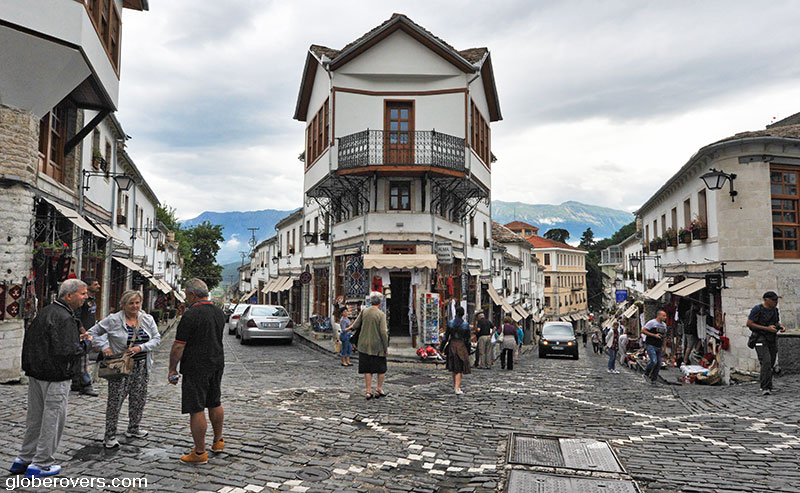
Looming over the town is the 12th century Gjirokastër Castle that was gradually built by despots and dictators over many centuries. The castle now houses ageing reminders of their resistance to Western occupation. The castle also has a very informative exhibition outlining the history of Albania, particularly life under Hoxha when the castle served as a notorious prison until 1968. The views from the castle over the town and the valley are stunning.

Gjirokastër castle. 
Gjirokastër castle. 
Views of Gjirokastër from the castle.
Don’t miss the monumental three-story Zekate House with its twin towers. Built in 1812, is said to be “one of the grandest examples of Gjirokastër architecture in the Ottoman style”
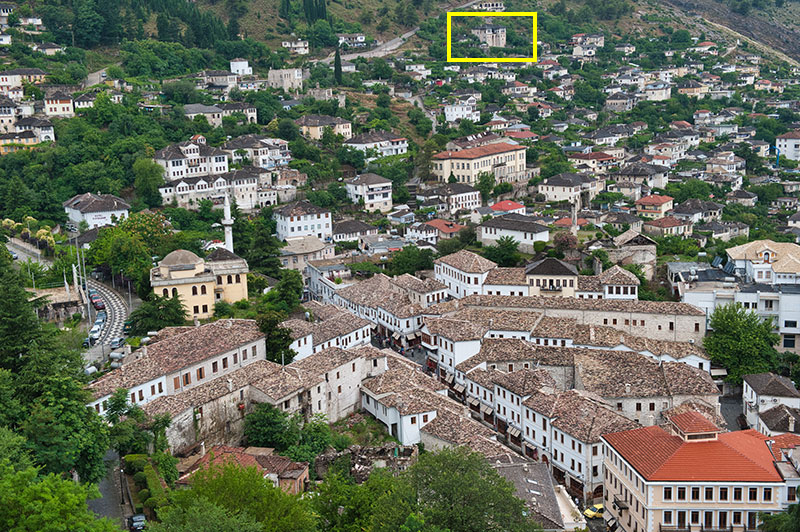
The town also has an interesting old bazaar. About three kilometres (1.9 mi) north of town along the highway to Tirana is Lake Liqeni i Viroit, a crystal clear lake fed by a strong fountain gushing out of the rocky hill at the upper end of the lake.
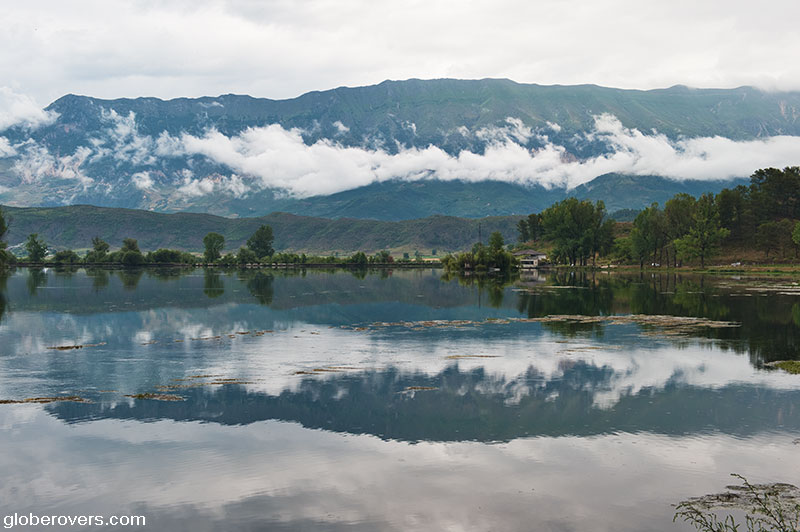
Sarandë, port city of the south
Sandwiched between the Ionian Sea and hills of olive groves, Sarandë is a resort town popular for its restaurants and entertainment atmosphere. Located on a horseshoe-shaped bay, the hilly town has a long promenade along a few beaches with many beach bars and restaurants.
Sarandë is a popular base from where to visit nearby attractions, including the Greek island of Corfu.
While the town itself doesn’t have the historical value of Gjirokastër, it offers a good selection of accommodation and a wide variety of restaurants. In recent years, tourism has flourished here. Many visitors use Sarandë as a base to visit nearby attractions such as the beaches to the north and south of town, the “Blue Eye” spring in the nearby hills, the Ottoman area mountain village of Gjirokastër, the ancient ruins of Butrint, and the 16th-century Lëkurësi Castle on a hilltop above the town. Sarandë is also the gateway to the nearby Greek Island of Corfu.
Sarandë is best described as a tourist-oriented family-friendly resort town in which to sleep, eat and take day trips to nearby natural attractions. If you want a less touristy place with a peaceful local vibe, then find accommodation at Ksamil village, just 14 kilometres (7 mi) south of Sarandë.
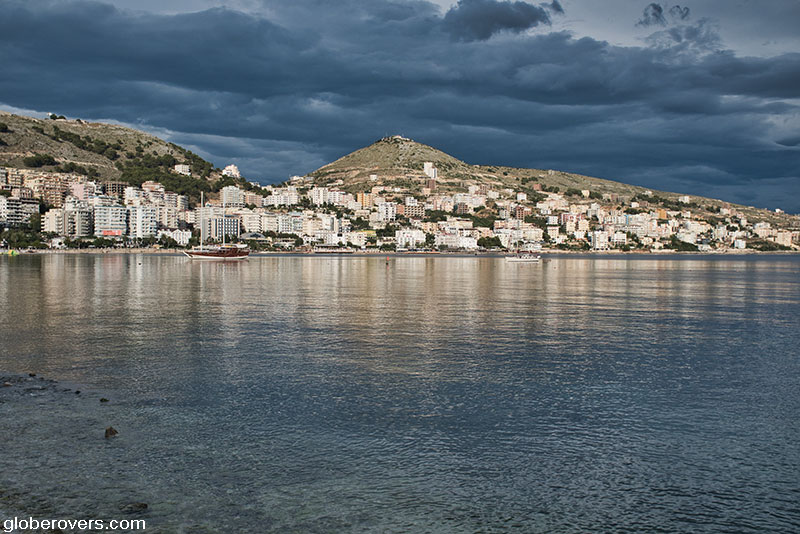
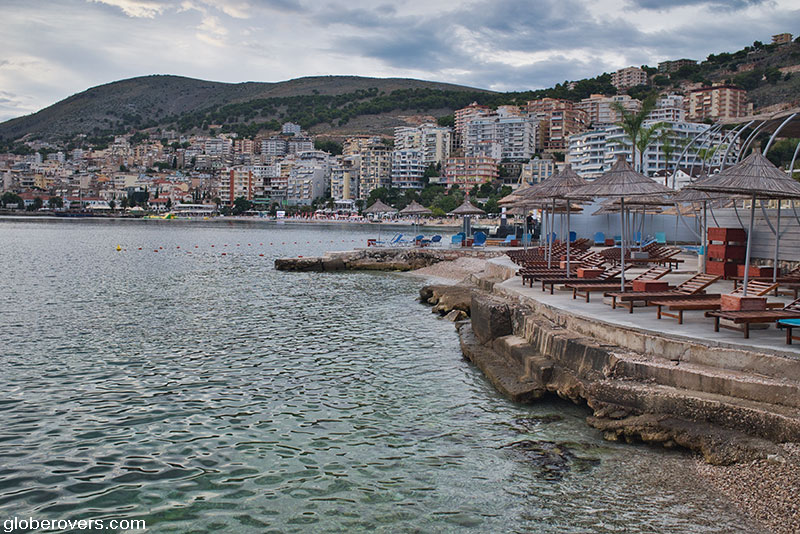
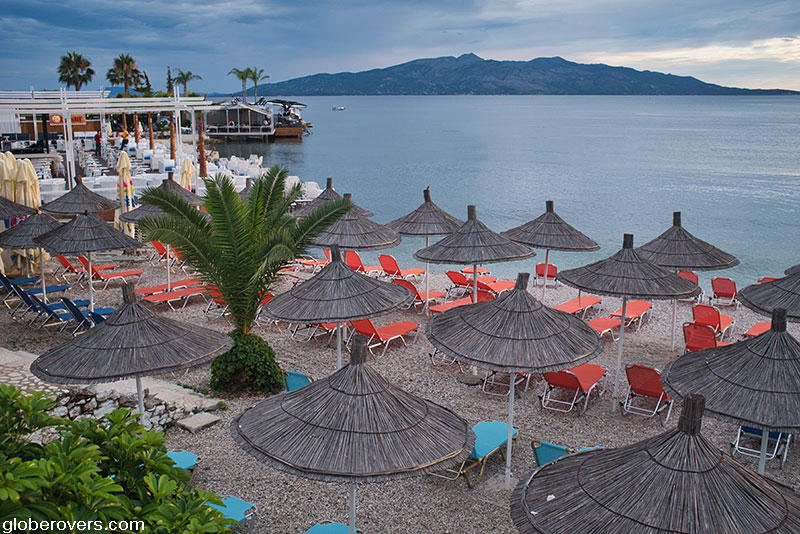
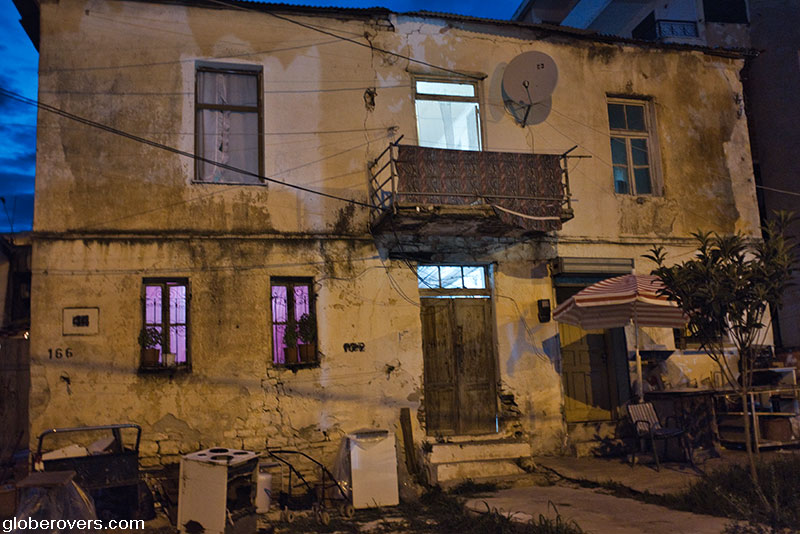
Ksamil’s turquoise beaches
Located at the bottom of an isthmus squeezed between the cobalt-coloured Adriatic Sea and a lagoon famed for its mussels, lies the pretty beach town of Ksamil. This is truly a beautiful spot located near the bottom of the Albanian Riviera.


Even though tourism is on the increase, the village is still sparsely populated with low density housing and a couple of low-rise holiday accommodation properties along the sea and the nearby lagoon. Many of the beach loungers sipping their cocktails are day-trippers from nearby Sarandë. July and August can get quite busy here with tourists from all over Europe so the best times to visit are between April and June, and from September to November.
Ksamil has among the most beautiful beaches in Europe!
Around Ksamil are a few interesting coves and beaches so it’s not difficult to find a peaceful spot with clean turquoise waters.
Within swimming distance from the town’s main beach are three small islands. While the nearest island is an easy swim, the other two will require a lot more effort and risk due to strong currents.

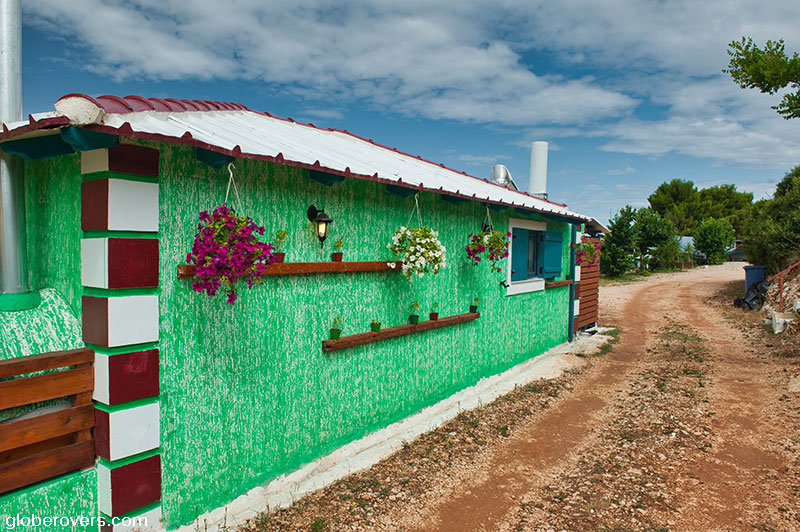

Butrint archaeological site
About five kilometres (3.1 miles) southeast of Ksamil, in a lovely natural setting, surrounded but lush greenery, Lake Butrint and the Vivari Channel, sit the ancient ruins of Butrint. The ruins have an eerie atmosphere created by a combination of the ancient archaeological monuments, undisturbed nature, and serene peacefulness – provided you visit at the right time.
Due to its isolation at the bottom end of Albania, Butrint has thus far escaped aggressive development, though that is going to change as tourism is increasing in this once isolated country.
Butrint was an important stop along a major trade route and was controlled by the Romans, Byzantines, Venetians, and Ottomans
Evidence suggests that Corfiot traders founded Butrint in the eighth century BC. Until the arrival of the Romans, Butrint was mainly influenced by Greek culture. In 44 BC, Butrint became a Roman colony. After a period of abandonment, Butrint was reconstructed extensively under Byzantine control during the 9th century.
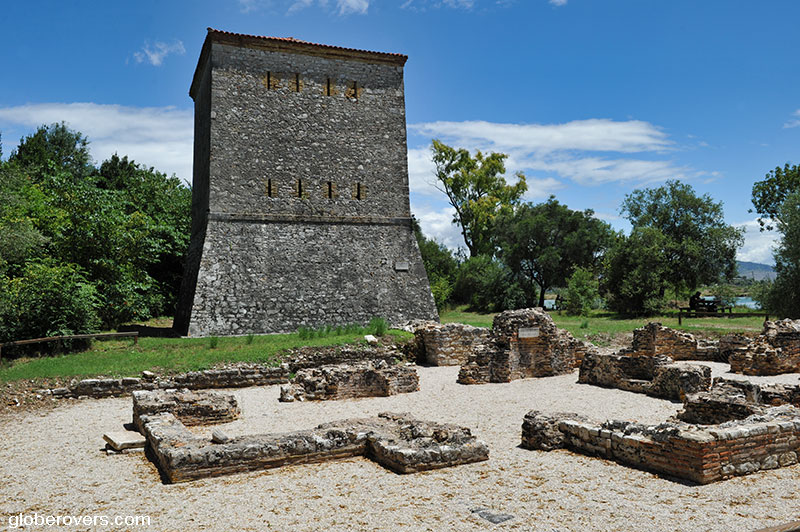
The Venetians took control during the 14th century and then the Ottomans ruled Butrint for centuries until the city’s final abandonment during the Middle Ages after a major earthquake flooded most of the city. Since then the area was occupied either by the Venetians or the Ottomans. From 1799 it was part of the Ottoman Empire until Albania gained its independence in 1913, by which time the original city had been unoccupied for centuries and was surrounded by marshes infested with malaria.
It is easy to spend a full day here and if it’s high tourist season, it’s better to arrive at the opening time (8 am) and visit all the main sights before the tourist buses arrive. Look out for the old Roman Theatre, Venetian Castle and the Great Basilica.

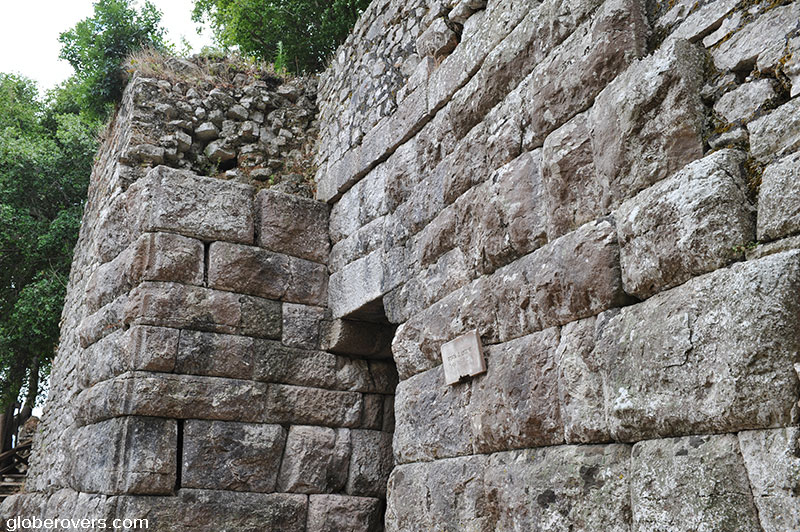
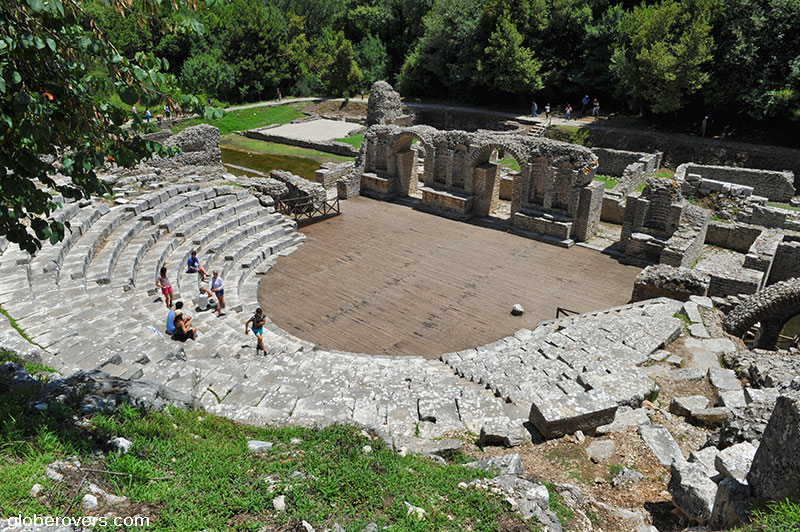

Great Basilica. 
Venetian Castle.
☛ Read more: Posts about Eastern Europe and Russia


Further reading
- Pyramids of Ancient Latin America
- Sacred Ruins of Yogyakarta, Java Island, Indonesia
- 10 Great Ruins of Latin American Empires
- 10 Best Countries for Sacred Architecture
- Butrint – Thousands of years of history (Photo essay)

Blog post and photos by Peter who has been travelling almost full-time since 2005 and has been to over 122 countries. He visited several countries, such as Japan, more than 20 times. Peter is Editor-in-Chief and Publisher of GlobeRovers Magazine, an independent travel magazine focused on intrepid destinations.

